IAP 2001, Presentation 4, PART 2:
MEASUREMENT OF CASE EXCHANGE RATES AND THE USE OF SUCH MEASUREMENTS
Hubertus Ankersmit +, Maximiliano Lebidinsky, Simon F. Watts
School of Biological and Molecular Sciences,
Oxford Brookes University
Instituut Collectie Nederland / Netherlands Institute for Cultural Heritage (ICN) +
PART 2: SLIDES FROM PRESENTATION:
IAP 2001
Observations from a Museum Case
Simon Watts, Max Libedinsky and Hubertus Ankersmit*
School of Biological and Molecular Sciences, Oxford Brookes University
*The Netherlands Institute for Cultural Heritage

Structure
- Aims of this work
- inter-relationship with other work
- case models
- The experimental set-up
- the case
- RH, T and N2O measurement
- Results
- sample
- obvious things
- less obvious things
- Conclusions
|
Style of Talk

Please interrupt with questions about the leaves!
Aims of this work
- To study intra-case differences of some chemical and physical parameters
- To identify appropriate parameters for case function description
- To test the Michalski type model for exchange processes
|
Inter-relationship with other work
- Frank Ligterink, Maarten van Bommel & Hubertus Ankersmit
(Institute for Cultural Heritage, Amsterdam)
- Andrew Calver (Museum of London)
|
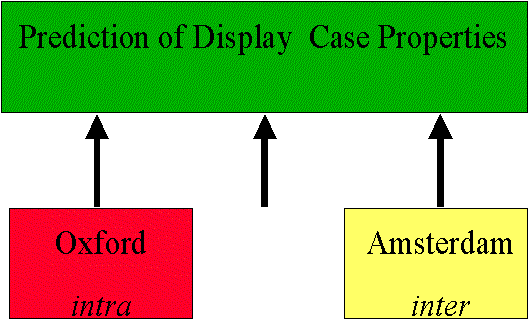
The "Case"
-
Dimensions 1m x 1m x 1.5 m
- Steel with plastic fixing and 4mm polycarbonate sides
- Corners with silicon sealant
|
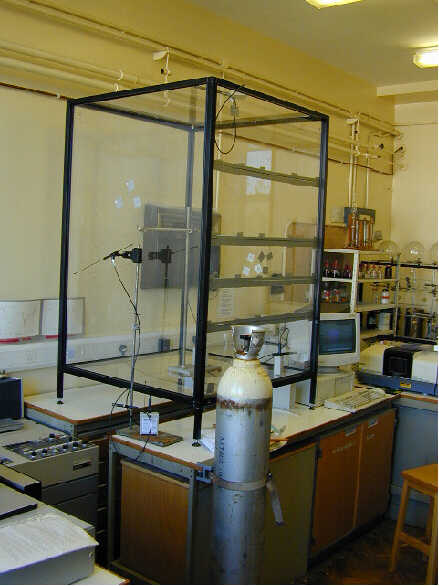
"Case" Specifications

- Holes
- 1 cm diameter
- Cracks (along top)
- 0.7 and 2.5 cm width
- Sealed with "Duck" tape
|
"Case" Layout
- Monitoring the "Case"
- Meaco Museum Control System
RH, T at 3 points in case
- top front LHS corner
- centre
- bottom RHS corner
- outside bottom LHS corner
- Analox N2O "Buddy"
N2O, T at 1 point in case
- mid front
- N2O inlet middle LHS and computer
fan bottom LHS front corner
|
The working "Case" I
The experiments involve injecting N2O into the case
and watching the loss under varying conditions
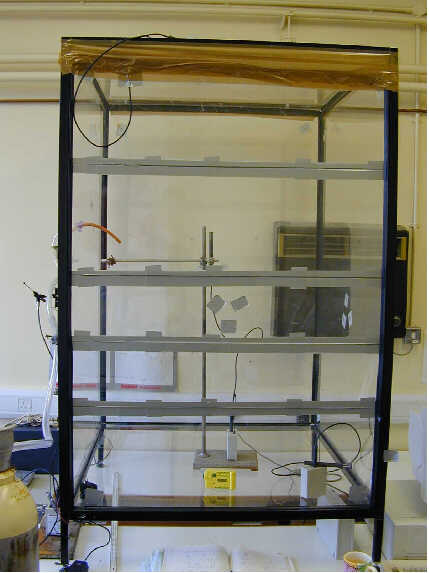
The "Case" Geography
- Differences in temperature between four probes
(A) ~ 0.5°C
(B) ~ 3°C
- Tells us that inside the case is not well mixed (hotter at top)
|
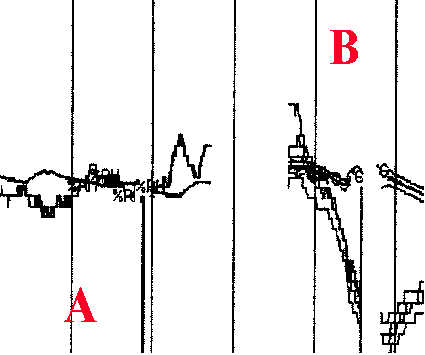
The working "Case" II

- Decay curve from fully closed case
- Slope (rate of exchange) gets progressively less
- Need a model or mathematical description before analysis & comparison
|
Interpretation

- The "Why" of a model
- Not a good fit to any of the expected models - NOT continuous curve
- Approximate N2O lifetime in case ~27 hours (CER 0.89 d-1)
|
The working model I
- Observations
- Temperature differences mean stratification inside case
- such stability implies separate air-masses
- Would explain "kinks" in curves and areas of decreasing slope
- Guessed two reservoirs - two stage box-model
(Truesdale, V.W. Watts, S.F. [2001] Deep Sea Research) **
|
The working model II
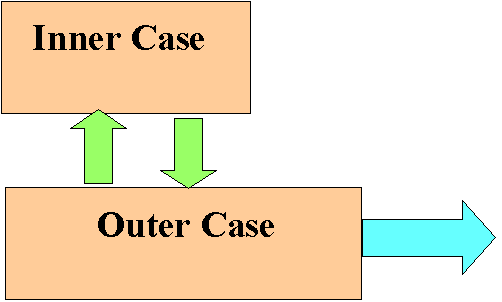

a & b are constants, t is time, and [N2O] is N2O concentration
First Test
- Use of fan should make case atmosphere uniform, shorter lifetimes, higher CER.
- Fan should fit standard model, this graph second order (!)
- Mauve without fan, black with fan. Steeper line, higher CER
|
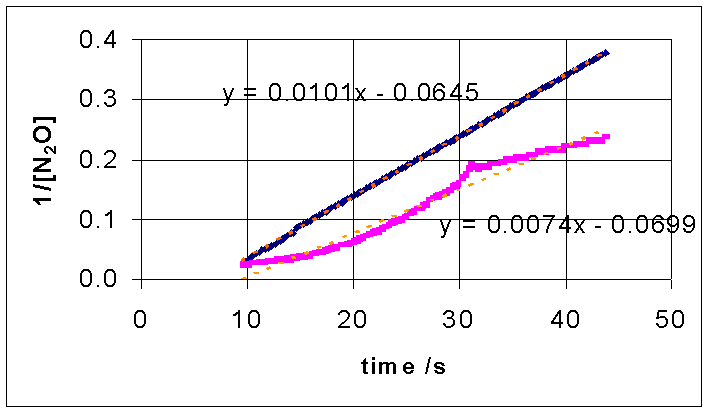
Implications
- Fan increases CER by ~ 30%
- Fan straightens out kinks, better fit to standard models (second order not understood!)
Normal museum cases do not have fans - hence CERs better than predicted
- Michalski's model does not comprehend second box
|
Affect on CER of holes
- Tests limited
- holes at same level
- holes at different level
- no cracks (yet!)
|
Cross-sectional hole area
/ 106 m2
|
Height
Difference
/ m
|
Slope of
1/[N2O] vs t line
/ 106 ppm-1
|
|
Fixed* | Variable
(planned holes) |
Total
(Fixed + Variable)
|
|
300 | 78.60 | 378 | 0 | 0.004
|
|
300 | 157.1 | 457 | 1.40 | 0.008
|
|
300 | 157.1 | 457 | 0 | 0.007
|
|
300 | 314.2 | 614.2 | 1.40 | 0.010
|
* (CER 0.88 d-1; Case volume 1.5 m3;Ps = 0.25 Pa.)
Conclusions
- From this work (in progress)
- intra - case effects are important for medium sized cases
- Michalski model does not seem to deal with
inhomogeneous air masses within cases very well
- More work is required to validate the entrainment type model
|
Ankersmit, H.
Instituut Collectie Nederland
Gabriel Metsustraat 8
Postbus 76709
1070 KA Amsterdam
Lebidinsky, M. and Watts, S.F.*
School of Biological and Molecular Sciences
Oxford Brookes University
Headington, Oxford, UK
OX3 0BP
E-mail: sfwatts@brookes.ac.uk*
(*): Author to whom correspondence may be addressed:

Index of presentations at IAP 2001 meeting
[ Page up ]
[ IAP Group homepage ]
[ Main IAQ in Museums homepage ]
[ Search site ]
Webmaster
Indoor Air Quality in Museums and Archives
© January 04th, 2002
